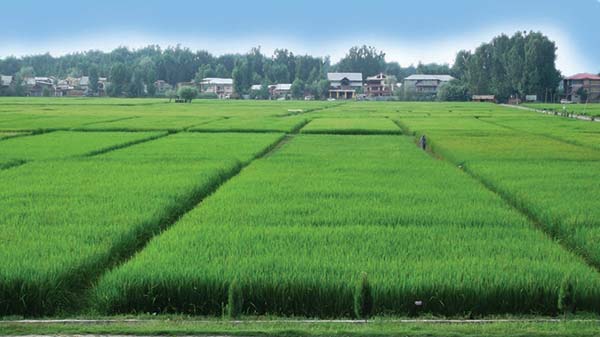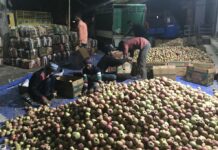Hardly anybody cared till the rice decorating elite marriages almost vanished from the fields. Shakir Mir reports Mushkbadij’s revival journey from mere 137 kgs to 2000 quintals in just three years

Gul Mohammad, 69, of Sagam village in Kokernag is an effable old man who smiles a sheepish smile every time people strike a conversation with him. He spends considerable time at his store besides slogging for hours at a vast expanse of land he owns nearby. A regular farmer though, Mohammad’s toil carries an added extra-worth given that his village is climatically one of the rarest places in Kashmir valley suitable for the cultivation of once near-extinct Mushkbudji, a scented variety of rice grain famous for giving away a resplendent aroma.
Sagam is an idyllic village straddling the famous tourist spot Kokernag and the Islamabad town. It is surrounded by lush green meadows replete with almond, apricot and peach orchards. During springs, Sagam is a palette of colours where large swaths of Mustard blossoms contrast sharply with the sky-rising Poplars and weeping willows whose pendulous branches skim idly on the surface of small water ponds forming from rains.
Over a thousand farmers in this village grow Mushkbudji across an estimated area of above 60 hectares annually producing nearly 3000 quintals of the two varieties of this aromatic rice. The other one is Kamad although farmers prefer Muhskbudji in view of its copious yield and robust aroma. At average, one kanal of land can produce 2.5 quintals of scented rice a year, farmers say.
The coveted rice variety is said to have vanished from the farmer’s field during 1960’s when uncontrolled Blast disease prompted diminishing returns. “The blast ruins the crop in exactly the same way as grenade destroys the area where it explodes,” says Latif Ahmad, an official from the Agricultural department. “This rice was extremely susceptible to diseases and therefore farmers abandoned it.”
For decades, very few growers among the farmer community of Sagam cultivated this rice variety. By 2005, Mushkbudji was going through its death throes.
Concerned about its “miserable” condition, some nine years ago, the Mountain Research Centre for Field Crops, SKUAST-K at Khudwani in Islamabad, began hammering out plans in collaboration with the agricultural department to resurrect the ailing crop from its death bed.
The program envisioned reviving the Mushkbudji in accordance with the three objectives including a concerted focus on genetic purification and marketing. The strategy, as planners saw it, would not only push the scented rice back into commercial space but also alleviate the socio-economic woes of the farmers.
If the current mood among farmers is any indication, the plan seems to have lived up to the expectations. “In 2011 when we handed them the first batch of rice seeds, they exuded a little interest,” Latif says. “Four years down the line, the farmers have not only earmarked more and more land for the growth of this crop but also signalled a keen interest in selling seeds back to the department to make a repository of sorts.”
Data substantiates his claim. In 2011, the total amount of area where Mushkbudji grew was around 0.2 hectares. The following year, it expanded to one hectare before finally sweeping a staggering 60 hectares of agricultural land in 2013.
The Agricultural Department is hopeful of appropriating another 60 kanals of land next year, suggesting overwhelming participation of farmers in this initiative.
In 2009, SKUAST-K took the first crack at breathing a fresh lease of life into the dying rice. A team of scientists made 51 selections of Mushkbudji and 64 selections of Kamad variety from various parts of Kashmir valley. “There selections were raised as head to toe progenies and characterized for yield, quality and disease reaction,” says Prof G A Parray, senior scientist and a Rice breeder at Khudwani campus. Parray’s has been an instrumental intervention in this endeavour. “It enabled us to identify the original varieties.”
These varieties were then cultivated to produce some 4 kgs of seeds. The seeds were given to the farmers of Sagam village which is a niche area for the cultivation of scented rice. “It rarely grows elsewhere.”

With the first harvest, farmers of Sagam churned out nearly one quintal and 37 kgs of rice produce. From this colossal seed base, farmers continued growing and expanding the Mushkbudij cultivation. The seeds were first treated and sown in nurseries. The fledgeling saplings were administered with the fertilizers before being transplanted into the fields. “We also provided the fungicides and other fertilizers free of cost,” Latif says.
Over two lakh rupees worth of fertilizers are estimated to have been provided to the farmers free of cost. “The ever-increasing produce benefitted the farmers economically,” says Parray. When the production reached nearly 2000 quintals in 2013, the SKUAST-K tied-up with a Jammu based miller, Sarveshwar Organic Foods Ltd, to manage the marketing of this revived variety.
“A quintal currently costs not less than Rs 20 thousand,” says Hilal, a grower in Sagam. The rice is quite expensive and is largely used during marriage ceremonies and served to guests at state dinners or at 5-star hotels.
Villagers also sell the rice locally, in fact, at a relatively cheaper price. “We sell a quintal for Rs 15 thousand,” Abdul Rashid Wani, a merchant at Sagam tells Kashmir Life adding that most of his clientele belongs to Srinagar city. “There is barely any place here where this expensive rice is bought,” he says. “In south Kashmir itself, its purchases are made only across few pockets.”
The high pricing hasn’t come without costs. The farmers complain about “poor” marketing and a dearth of buyers. “If the only government could start marketing the rice more aggressively than it is currently, the growth of this crop may boost our economic conditions,” says, Mohi-u-din, a farmer who is keenly pursuant of popularizing this rice amongst big hotels.
But the woes are more than just one. Even though the key fertilizers and fungicides meant to fend off Blast infestation are currently being offered at no cost, government, some fear, may stop doling out freebies once the Mushkbudji cultivation stabilizes. “It won’t be wrong either if the government takes the step,” an official says.
But much to their delight, scientists at SKUAST-K Khudwani are planning to roll out a genetically modified Mushkbudji variety within two years. “The new variety will be durable and disease-resistant,” says Parray. “Not only will it withstand Blast but also tolerate the colder conditions. It will usher in a new era of progress.”















